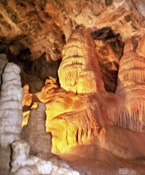Touring Ancient Aquifers
January 10, 2008

<< Return to ‘Edge of the Desert’…
Although the water supply is a decidedly modern topic, the study of water, like all environmental issues, can benefit from a geological perspective. Deep in the caves of Texas lies a valuable repository of water data—the history of water pathways through ancient aquifers. These data are important to studying past climate changes, as well as to understanding modern-day water resources.
Speleothems, better known as stalactites and stalagmites, provide a record of how the composition of water infiltrating a cave has changed over time. “Basically, these are deposits of the mineral calcite that form from waters dripping into the cave,” says Jay Banner, director of the Environmental Science Institute at the University of Texas at Austin and a professor at the Jackson School of Geosciences.
Banner and his colleagues have been precisely dating the layers of growth on these formations, and then inferring from their composition how water flow patterns have changed over time. They can then use independent climate records from the same period of time to examine how aquifers have been responding to local, regional and global climatic shifts.
This information can inform both water and climate models. “If we’re going to be able to predict the future, we need to have this baseline established of what things were like in the past and in particular before humans perturbed the landscape and our environment,” Banner says.
In Texas, Banner is specifically looking at 10,000 to 80,000 year old speleothem formations in the Edwards aquifer, an intricate network of underground caves and passages in Central Texas. The goal is to understand how global ice age events were affecting local climate and the water flow into the caves. He is also looking at formations from the past 10,000 years, to home in on how humans may have impacted the ancient water systems. —LMP
<< Return to ‘Edge of the Desert’…
By Lisa M. Pinsker
For more information about the Jackson School contact J.B. Bird at jbird@jsg.utexas.edu, 512-232-9623.
